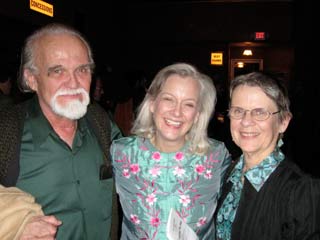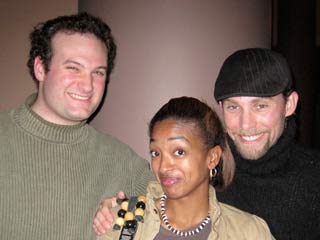Left Holding The Mop
by Anthony Chase
Opening Shots
The playwrights, Bradford Willis (left) and Anne Dunkin (right), in from California, visit with cast member Kate Olena (center)

Cast members Jeffrey Coyle, Jasmine Ramos, and Michael Seitz

Alleyway Stage Manager Ann Perno with Left Holding the Mop star Laura Bevilaqua and cast member Carlton Franklin
|
Left Holding the Mop is a moralistic little piece of theater about a crisis in American education. Here we meet Lara Arek, an idealistic new teacher preparing to face her first class of students. She aspires to open minds and to lead her charges to the wonders of learning. What she finds, instead, is a system mired down by testing, benchmark goals, and an administration oblivious and insensitive to the educational process. She finds that good teaching is not valued but that high test scores are—no matter how they are achieved or what damage is inflicted in the process.
Bradford Willis and Anne Dunkin are California-based writers who have used their own experiences and observations about education to devise this play. The approach they have taken is interestingly expressionistic at times, and playfully takes the action into a simplified world of make-believe. Characters represent educational archetypes. In addition to our heroine, played with wide-eyed eagerness by Laura Bevilacqua, we meet the scheming school administrator who loves her; the once-idealistic colleagues who have given up; the ambitious school board members who haven’t got a clue; the vulnerable but clever child in need, and so forth. I was reminded, at several points, of Elmer Rice, who followed the deadly life of Mr. Zero, the bookkeeper in his play, The Adding Machine.
Still, real teachers will recognize such details as the mountains of manila envelopes that symbolize testing over teaching as being very real. In that regard, that the play is didactic is not a flaw. The didactic, after all, was the stock and trade of playwrights as powerful as Rice, Brecht and even Ibsen. There is, moreover, something appealing about eager little Lara Arek (and appealing Miss Bevilacqua is little), and the comical villains she encounters.
The play does seem to be calibrated to a specialized audience. I could easily see it playing to crowds of cheering teachers, PTAs, or education students. On this circuit, it could tour across the country and back again. The teachers sitting behind me were reacting almost viscerally, and the intermission was excited with real-life tales of public school horrors.
The climactic scene, in which Lara is summoned to a closed meeting of the board of education, is woefully overwritten. Here, the authors needlessly endeavor to jam points they have already made into heroic speechifying. It is not necessary. This is, of course, the play’s debut—the authors had never even heard actors read the words aloud before; it is likely that this production will inspire editing.
Directed and designed by Neal Radice, in addition to Miss Bevilacqua, Left Holding the Mop features Michael Seitz as her administrator boyfriend; Carlton Franklin as the professor and other characters; Kate Olena as a variety of heinous mal-educators; and Jasmine Ramos and Jeffrey Coyle as two Childs Left Behind.
It is a quirky play that has a message with a vengeance. Those who feel strongly about the direction of American education will find it energizing.
|
Issue Navigation> Issue Index > v8n46 (week of Thursday, November 12) > Theaterweek > Left Holding The Mop This Week's Issue • Artvoice Daily • Artvoice TV • Events Calendar • Classifieds |









 Current Issue
Current Issue